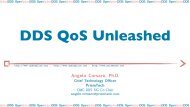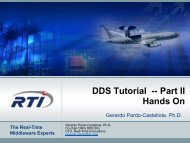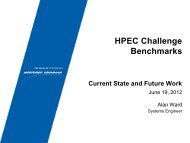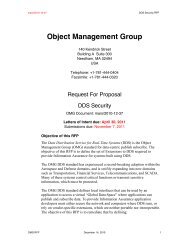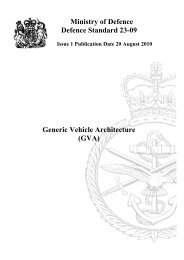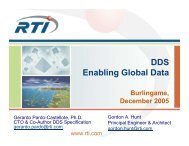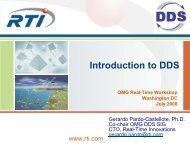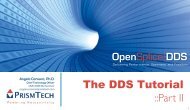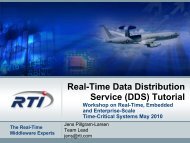The DDS Tutorial - Part I
The DDS Tutorial - Part I
The DDS Tutorial - Part I
- No tags were found...
Create successful ePaper yourself
Turn your PDF publications into a flip-book with our unique Google optimized e-Paper software.
OpenSplice <strong>DDS</strong>Delivering Performance, Openness, and FreedomYour will learn:- What is a Topic- How to define Topic Types- How to register a TopicStep IDefining the Data
TopicsTopic‣ Unit of information atomicallyexchanged between Publisher andSubscribers.‣ An association between a unique name,a type and a QoS setting© 2009, PrismTech. All Rights Reserved
Topic TypesA <strong>DDS</strong> Topic Type is described by an IDL Structure containing an arbitrary number forfields whose types might be:‣ IDL primitive types, e.g., octet, short, long, float, string (bound/unbound), etc.‣ Enumeration‣ Union‣ Sequence (bounded or unbounded)‣ Array‣ Structure (nested)© 2009, PrismTech. All Rights Reserved
Examplesstruct HelloTopicType {string message;};struct PingType{longstring};counter;vendor;struct ShapeType {long x;long y;long shapesize;string color;};enum TemperatureScale {CELSIUS,FAHRENHEIT,KELVIN};struct TempSensorType {short id;float temp;float hum;TemperatureScale scale;};struct Counter {long cID;long count;};© 2009, PrismTech. All Rights Reserved
Topic Types & Keys‣ Each Topic Type has to define its key-set (which might be the empty set)‣ <strong>The</strong>re are no limitations on the number of attributes used to represent a key‣ Keys can be top-level attributes as well as nested-attributes (i.e. attributes in nestedstructures)© 2009, PrismTech. All Rights Reserved
Key Examples -- Empty Key-Setstruct HelloTopicType {string message;};#pragma keylist HelloTopicTypestruct PingType{longcounter;string vendor;};#pragma keylist PingType© 2009, PrismTech. All Rights Reserved
Key Examples -- User-Defined Keysstruct ShapeType {long x;long y;long shapesize;string color;};#pragma keylist ShapeType colorstruct Counter {long cID;long count;};#pragma keylist Counter cIDenum TemperatureScale {CELSIUS,FAHRENHEIT,KELVIN};struct TempSensorType {short id;short roomid;float temp;float hum;TemperatureScale scale;};#pragma keylist TempSensorType id roomid© 2009, PrismTech. All Rights Reserved
Topic Keys Gotchas‣ Keys are used to identify specific data “instances”‣ It we want to make a parallel with OO then we could say that:‣Keyless Topic as singletons, e.g. there is only one instance!‣Keyed Topics identify a class of instances. Each instance is identified by a key value‣ Think at each different key value as really instantiating a new “object” in your system. That will avoidmaking mistakes in your keys assignment‣ Never do something like this:struct Counter {long cID;long count;};#pragma keylist Counter count... As it will create a new topic instance for each ping you send thus consuming an unboundedamount of resources!© 2009, PrismTech. All Rights Reserved
Compiling Topic Types‣ Topic types have to be compiled with the <strong>DDS</strong>-provided IDL compiler‣ <strong>The</strong> compilation process will take care of generating code for‣ Strongly typed Reader and Writers‣ Type Serialization‣ When compiling a target language should be chosen, such as C/C++/Java/C#‣ Example:$ idlpp -S -l cpp -d gencxx ShapeType.idl$ idlpp -S -l java -d genjava ShapeType.idlStandalone modeTarget Language Target Directory Target File© 2009, PrismTech. All Rights Reserved
IDL Compilation in SIMD‣ SIMD provides a template makefile that you can use to compile your IDL files.‣ <strong>The</strong> default language is C++ (as SIMD currently supports only C++)Makefile.idl#-*-Makefile-*-include $(SIMD_HOME)/config/apps/Macros-idl.GNUTARGET_IDL=ShapeType.idlinclude $(SIMD_HOME)/config/apps/Rules-idl.GNU© 2009, PrismTech. All Rights Reserved
Putting it all TogetherCirclestruct ShapeType {long x;long y;long shapesize;string color;};#pragma keylist ShapeType colorTopicQoS© 2009, PrismTech. All Rights Reserved
Registering Topics with SIMD‣ SIMD provides several constructors that allow to register a topic:Topic(const std::string& name);Topic(const std::string& name, const TopicQos& qos);Topic(const std::string& name, const std::string& type_name);Topic(const std::string& name, const std::string& type_name, const TopicQos& qos);© 2009, PrismTech. All Rights Reserved
Registering the Circle TopicCirclestruct ShapeType {long x;long y;long shapesize;string color;};#pragma keylist ShapeType colorTopicDefaultQoSdds::Topic shape(“Circle”);© 2009, PrismTech. All Rights Reserved
OpenSplice <strong>DDS</strong>Delivering Performance, Openness, and FreedomYour will learn:- What are <strong>DDS</strong> <strong>Part</strong>itions- How to partitions workStep IIDefining the Scope
More about <strong>Part</strong>itions‣ Each partition is identified by astring, such as “sensor-data”,“log-data” etc.‣ Read/Write access to apartition is gained by means of<strong>DDS</strong> Publisher/Subscribers‣ Each Publisher/Subscribercan be provided with a list of<strong>Part</strong>itions name, which mightas well include wildcards ,orgeneric regular expression,such as “*-data”<strong>Part</strong>ition<strong>DDS</strong>Global Data Space© 2009, PrismTech. All Rights Reserved
<strong>Part</strong>ition as Namespaces‣ Although <strong>DDS</strong> does not support explicit nesting of partitions, a powerful way of organizing yourdata is by always using a hierarchical “dotted” notation to describe them.‣ For instance, for a building in which you are deploying the new temperature control system youmight use a scheme such as “building.floor-level.room-number” for scoping the data that flowsin each room.‣ building.floor-2.room-10‣ building.floor-3.room-15‣ In this way, accessing the data for a specific floor can be done by using the partitionexpression “building.floor-2.*”‣ While the data for all the building is available via “building.*”© 2009, PrismTech. All Rights Reserved
Emulating <strong>Part</strong>ition Nesting“building.floor-1.*”“building”“building.floor-1”...“building.floor-1.room-1”“building.floor-1.room-2”“building.floor-2”“building.floor-N”“building.floor-N.room-1”“building.floor-2.room-1”“building.floor-2.room-2”.........“building.floor-N.room-2”© 2009, PrismTech. All Rights Reserved
Connecting to <strong>Part</strong>itions in SIMD‣ SIMD provides two ways of connecting to partitions.‣ A simple one is to bound the full runtime to a partition expression by passing a string to theRuntime class at construction time‣ <strong>The</strong> other is to configure a specific Publisher/Subscriber with the relevant list of partitionsRuntime();Runtime(const std::string& partition);Runtime(const std::string& partition, const std::string& domain);Publisher(const std::string& partition);Publisher(const std::string& partition, ::dds::Domain<strong>Part</strong>icipant dp);Publisher(const ::dds::PublisherQos& qos, ::dds::Domain<strong>Part</strong>icipant dp);Subscriber(const std::string& partition);Subscriber(const std::string& partition, ::dds::Domain<strong>Part</strong>icipant dp);Subscriber(const ::dds::SubscriberQos& qos, ::dds::Domain<strong>Part</strong>icipant dp);© 2009, PrismTech. All Rights Reserved
OpenSplice <strong>DDS</strong>Delivering Performance, Openness, and FreedomYour will learn:- What is a Data Writer- How to Create a Data Writer- How to write DataStep IIIProducing the Data
Writing Data in SIMD‣ Writing data with SIMD takes two steps.‣ First you have to create the DataWriter by using the proper constructor (thisdepends on the level of customization you require)‣ <strong>The</strong>n, you’ll have to decide how you want to write the data© 2009, PrismTech. All Rights Reserved
Creating a DataWriter‣ SIMD provides different DataWriter constructors allowing to control thelevel of customization required for the specific writertemplate class dds::pub::DataWriter : public dds::core::Entity {public:DataWriter();DataWriter(Topic topic)DataWriter(Topic topic, const DataWriterQos& qos)DataWriter(Topic topic, const DataWriterQos& qos, Publisher pub);// ...};© 2009, PrismTech. All Rights Reserved
Writing Data with SIMD‣ SIMD provides two generic writes as well as a method for creating a writerdedicated to a specific instance‣ <strong>The</strong> DataInstanceWriter provides constant time writes as it does notneed to look-up the key-fields<strong>DDS</strong>::ReturnCode_t write(const T& sample);<strong>DDS</strong>::ReturnCode_t write(const T& sample, const <strong>DDS</strong>::Time_t& timestamp);DataInstanceWriter register_instance(const T& key);© 2009, PrismTech. All Rights Reserved
Writing “Circling” Circle Samples© 2009, PrismTech. All Rights Reserved
OpenSplice <strong>DDS</strong>Delivering Performance, Openness, and FreedomYour will learn:- Reading vs Taking data- Sample State- How to Create a Data Reader- How to read/take dataStep IVConsuming Data
Reading SamplesDataReaderSamples Read1 1 1 2 1 3 1 42 1 2 2 2 33 1 3 2 3 3 3 4 3 5Samples not ReadDataReader CacheTopic‣ Read iterates over theavailable sample instances‣ Samples are not removedfrom the local cache asresult of a read‣ Read samples can be readagain, by accessing thecache with the properoptions (more later)struct Counter {int cID;int count;};#pragma keylist Counter cIDProprietary Information - Distribution without Expressed Written Permission is Prohibited.© 2009, PrismTech. All Rights Reserved
Reading SamplesDataReader1 1 1 2 1 3 1 42 1 2 2 2 33 1 3 2 3 3 3 4 3 5Samples ReadSamples not ReadDataReader CacheTopic‣ Read iterates over theavailable sample instances‣ Samples are not removedfrom the local cache asresult of a read‣ Read samples can be readagain, by accessing thecache with the properoptions (more later)struct Counter {int cID;int count;};#pragma keylist Counter cIDProprietary Information - Distribution without Expressed Written Permission is Prohibited.© 2009, PrismTech. All Rights Reserved
Reading SamplesDataReader1 1 1 2 1 3 1 42 1 2 2 2 33 1 3 2 3 3 3 4 3 5DataReader CacheTopicSamples Read Samples not Read‣ Read iterates over theavailable sample instances‣ Samples are not removedfrom the local cache asresult of a read‣ Read samples can be readagain, by accessing thecache with the properoptions (more later)struct Counter {int cID;int count;};#pragma keylist Counter cIDProprietary Information - Distribution without Expressed Written Permission is Prohibited.© 2009, PrismTech. All Rights Reserved
Taking SamplesDataReader1 1 1 2 1 3 1 42 1 2 2 2 33 1 3 2 3 3 3 4 3 5Samples not TakenDataReader CacheTopic‣ Take iterates over theavailable sample instances‣ Taken Samples areremoved from the localcache as result of a take‣struct Counter {int cID;int count;};#pragma keylist Counter cIDProprietary Information - Distribution without Expressed Written Permission is Prohibited.© 2009, PrismTech. All Rights Reserved
Taking SamplesDataReader1 2 1 3 1 42 2 2 33 2 3 3 3 4 3 5Samples not TakenDataReader CacheTopic‣ Take iterates over theavailable sample instances‣ Taken Samples areremoved from the localcache as result of a takestruct Counter {int cID;int count;};#pragma keylist Counter cIDProprietary Information - Distribution without Expressed Written Permission is Prohibited.© 2009, PrismTech. All Rights Reserved
Taking SamplesDataReader1 3 1 42 33 3 3 4 3 5DataReader CacheTopicSamples not Taken‣ Take iterates over theavailable sample instances‣ Taken Samples areremoved from the localcache as result of a takestruct Counter {int cID;int count;};#pragma keylist Counter cIDProprietary Information - Distribution without Expressed Written Permission is Prohibited.© 2009, PrismTech. All Rights Reserved
DataReaderSample, Instance and View StatesHistory Depth = 21 12 23SampleInfo1 1 1 22 2 2 33 1SamplesTopicDataReader Cache‣ Along with data samples, DataReaders are providedwith state information allowing to detect relevanttransitions in the life-cycle of data as well as datawriters‣ Sample State (READ | NOT_READ): Determineswether a sample has already been read by thisDataReader or not.‣ Instance State (ALIVE, NOT_ALIVE, DISPOSED).Determines wether (1) writer exist for the specificinstance, or (2) no matched writers are currentlyavailable, or (3) the instance has been disposed‣ View State (NEW, NOT_NEW). Determines wetherthis is the first sample of a new (or re-born) instanceProprietary Information - Distribution without Expressed Written Permission is Prohibited.© 2009, PrismTech. All Rights Reserved
Application / <strong>DDS</strong> Coordination<strong>DDS</strong> provides three main mechanism for exchanging information with the application‣ Polling. <strong>The</strong> application polls from time to time for new data or status changes. <strong>The</strong>interval might depend on the kind of applications as well as data‣ WaitSets. <strong>The</strong> application registers a WaitSet with <strong>DDS</strong> and waits (i.e. is suspended)until one of the specified events has happened.‣ Listeners. <strong>The</strong> application registers a listener with a specific <strong>DDS</strong> entity to be notifiedwhen relevant events occur, such as state changes orProprietary Information - Distribution without Expressed Written Permission is Prohibited.© 2009, PrismTech. All Rights Reserved
Reading Data with SIMD/*** Reads all new samples from any view state and alive instances. Notice* that this call is intended to loan the samples as* well as the infos containers, thus will require a* return_loan.*/<strong>DDS</strong>::ReturnCode_t read(TSeq& samples, <strong>DDS</strong>::SampleInfoSeq& infos)/*** Reads at most max_samples samples that have not been* read yet from all vies and alive instances.*/<strong>DDS</strong>::ReturnCode_t read(TSeq& samples, long max_samples)/*** Most generic read exposing all the knobs provided by* the OMG <strong>DDS</strong> API.*/<strong>DDS</strong>::ReturnCode_tread(TSeq& samples, <strong>DDS</strong>::SampleInfoSeq& infos,long max_samples,<strong>DDS</strong>::SampleStateMask samples_state, <strong>DDS</strong>::ViewStateMask views_state,<strong>DDS</strong>::InstanceStateMask instances_state)<strong>DDS</strong>::ReturnCode_treturn_loan(TSeq& samples, <strong>DDS</strong>::SampleInfoSeq& infos);Proprietary Information - Distribution without Expressed Written Permission is Prohibited.© 2009, PrismTech. All Rights Reserved
Taking Data with SIMD/*** Reads all new samples from any view state and alive instances. Notice* that this call is intended to loan the samples as* well as the infos containers, thus will require a* return_loan.*/<strong>DDS</strong>::ReturnCode_t take(TSeq& samples, <strong>DDS</strong>::SampleInfoSeq& infos)/*** Reads at most max_samples samples that have not been* read yet from all vies and alive instances.*/<strong>DDS</strong>::ReturnCode_t take(TSeq& samples, long max_samples)/*** Most generic read exposing all the knobs provided by* the OMG <strong>DDS</strong> API.*/<strong>DDS</strong>::ReturnCode_ttake(TSeq& samples, <strong>DDS</strong>::SampleInfoSeq& infos,long max_samples,<strong>DDS</strong>::SampleStateMask samples_state, <strong>DDS</strong>::ViewStateMask views_state,<strong>DDS</strong>::InstanceStateMask instances_state)Proprietary Information - Distribution without Expressed Written Permission is Prohibited.© 2009, PrismTech. All Rights Reserved
WaitSets in SIMD‣ SIMD provides a strongly typed WaitSet that supports automatic dispatching to functors‣ <strong>The</strong> best way of understanding SIMD waitsets is to look at an example:Proprietary Information - Distribution without Expressed Written Permission is Prohibited.© 2009, PrismTech. All Rights Reserved
Listenersin SIMD‣ SIMD provides a stronglytyped Listeners based onthe Signals/Slots patterns‣ <strong>The</strong> best way ofunderstanding SIMDListeners is to look at anexample...Proprietary Information - Distribution without Expressed Written Permission is Prohibited.© 2009, PrismTech. All Rights Reserved
OpenSplice <strong>DDS</strong>Delivering Performance, Openness, and FreedomStep VCompile and Run...
What You’ve Learned today‣ Defining Topics and Topic Types‣ Scoping Information with <strong>Part</strong>itions‣ Writing Data‣ Reading (Taking) data with Waitsets and Listeners‣ Writing an example that demonstrate all of the above© 2009, PrismTech. All Rights Reserved
What I’ll Cover Next Time‣ Content Filtered Topics and Queries‣ QoS and the Request vs. Offered Model‣ Setting QoS on <strong>DDS</strong> Entities‣ Tuning OpenSplice <strong>DDS</strong> Configuration© 2009, PrismTech. All Rights Reserved
Online Resourceshttp://www.opensplice.com/emailto:opensplicedds@prismtech.comhttp://www.slideshare.net/angelo.corsarohttp://bit.ly/1Sreghttp://twitter.com/acorsaro/http://www.youtube.com/OpenSpliceTubehttp://opensplice.blogspot.com© 2009, PrismTech. All Rights Reserved




